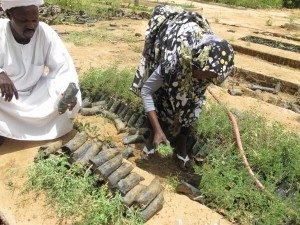Africa- The Future, and How You Can Help with ITF
It also highlights the possibilities of limiting and even reversing the damage already done. This programme left me, and I’m sure most viewers, with an urgent sense that action must be taken, and a fear that not enough will be done.
We know that large institutions, governments and private companies have to make the right decisions in order to safeguard the future of our environment – and at the same time we do individually have the power to help.
Working to reduce and reverse desertification
As shown in the programme, the Sahara is expanding and threatening habitats and livelihoods at its edges. Dedicated community groups are working to plant trees at the edge of the Sahara to try to combat this.ITF’s drylands projects in Ghana, Mali and Senegal promote farmer-managed natural regeneration and agroforestry to slow and reverse desertification. This rehabilitates landscapes and provides increased and sustainable income for communities across the African Sahel region, improving livelihoods and strengthening civil society.
Planting trees in these areas not only protects the habitats and environment on the edge of the Sahara, but for communities it increases sustained access to nutritious food, sustainability of income and improves soil quality and productivity of land as trees enrich the soil they grow and shed their leaves in, as well as releasing water vapour and providing shade and habitats for birds, for example.
This increased income and food security for communities also addresses the underlying causes of vulnerability to conflict which are shown by UN studies to be food insecurity and land degradation.
As with all our agroforestry projects, it ensures that human needs and the protection of the environment support one another rather than competing.
ITF needs your help to work with these communities to protect themselves from food instability, land degradation and poverty, and to protect land from desertification.
Protecting ecosystems
Tropical forests are home to as much as 50% of the world’s plant and animal species, are a powerhouse of the world’s weather, and are threatened by logging and encroaching agriculture.
ITF’s sustainable community forestry programmes work to ensure that the needs of humans and the needs of the environment are not mutually destructive, but can support one another sustainably. We work with local communities to plant trees, slow and reverse deforestation, increase sustained income and meet nutritional needs while improving soil and water quality and reducing pressure on forest resources.
One of our project partners, for example, protects the forest on the slopes of Mount Kenya, with community groups acting as forest guardians, reporting illegal activities that lead to deforestation, while planting thousands of trees to regenerate the forest and protect the banks of the six rivers that originate in this area from soil erosion, so that the water quality is improved and water is not lost to deforestation.
These projects, like the ones shown in the television programme, show that there can be hope for communities and wildlife in these threatened areas, with communities improving their livelihoods and those of plants and animals simultaneously through sustainable community forestry.
As ever, we need your help to work with communities to do this work. If after watching the BBC’s Africa, The Future you, like me, felt motivated to ensure the future health of the environment and its inhabitants, but didn’t know how, then here is one way you can help. Support the work of ITF. The bigger we grow, the more trees we can plant, biodiversity we can preserve, and the more we can ensure that the growing needs of the human population do not exclude the needs of the environment we live in and alongside.
Donate Today
Support communities on the front lines of the climate crisis to plant trees, restore ecosystems and improve their livelihoods.



